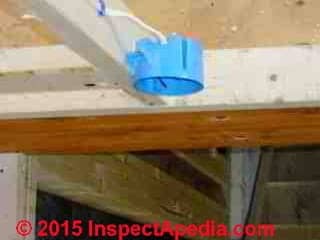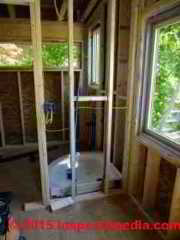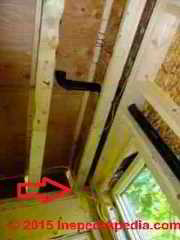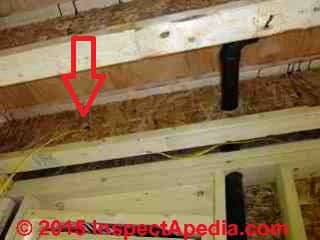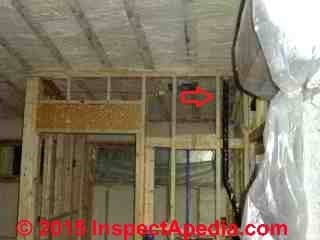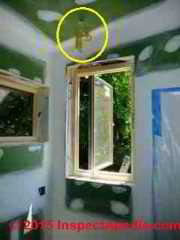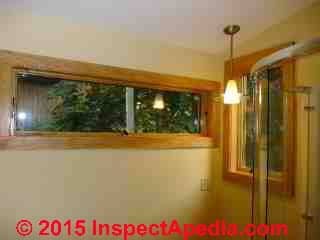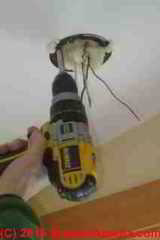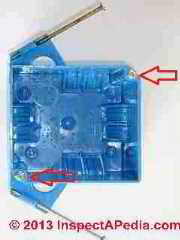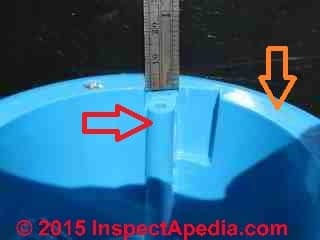 Plastic Electrical Box Repairs
Plastic Electrical Box Repairs
How to fix or replace a broken plastic ceiling or wall electrical box;
Causes of plastic electrical box failure, falling from ceilings or walls
- POST a QUESTION or COMMENT about fixing a loose ceiling light fixture traced to a broken electrical box whose supports snapped off.
Repair a broken plastic electrical box mounted in a ceiling or wall
This article describes how to repair a ceiling light fixture electrical box that was falling out of the ceiling, beginning with an explanation of how and why broken plastic electrical box swing clamp supports allowed the electrical box to fall from the ceiling leaving the light fixture hanging by its electrical wires.
In the second part of this article, "Ceiling Light Fixture Installation" we use an "old work" electrical box to replace the damaged box, secure the new box and re-mount the light fixture safely.
We discuss the requirement for secure mounting of ceiling electrical boxes for fans and lights and we give step by step details for installing a replacement electrical box, insulating around it, connecting the ceiling light wires, and then testing and completing the installation.
The electrical box repair or replacement procedures described in this article series describes step by step repairs for both metal and plastic electrical boxes used in building electrical wiring systems.
InspectAPedia tolerates no conflicts of interest. We have no relationship with advertisers, products, or services discussed at this website.
- Daniel Friedman, Publisher/Editor/Author - See WHO ARE WE?
How to fix a loose, broken or damaged plastic electrical box falling out of place

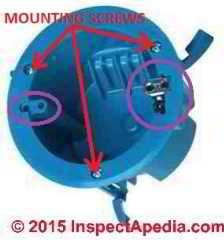
Cause of Ceiling Light Fixture Support Box Failure
The bathroom ceiling light shown above was found one morning hanging by its electrical wires: the plastic electrical box from which the light fixture was suspended was itself falling out of the ceiling - a dangerous situation risking fire or shock, more-so for a light fixture suspended over a bathroom sink. What happened?
Watch out: The round Carlon B618R electrical box used for the original light installation was a Carlon 4 1/4" diameter electrical box that is specifically indicated by the manufacturer as not for fixture support in the ceiling.
The concern is that the weight of a light fixture may pull the swing clips through the drywall or cause it to break, or the weight or movement of a heavy light fixture or ceiling fan may cause the swing clips themselves to break.
A falling light fixture or fan can kill someone or could start a building fire.
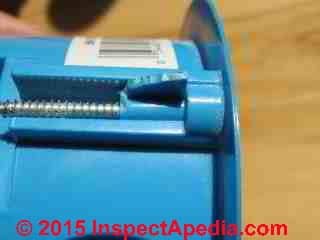 But this light fixture installation failed for a different reason: the swing clamps were tightened using a high-speed and powerful battery-operated drill mounted with a phillips bit to speed the fixture installation.
But this light fixture installation failed for a different reason: the swing clamps were tightened using a high-speed and powerful battery-operated drill mounted with a phillips bit to speed the fixture installation.
The swing clamp screws were so over-tightened against the drywall ceiling that all three of them cracked and two broke off completely.
A closer inspection of the original blue plastic electrical box to which the light fixture had been mounted discovered that two of the three plastic clips or "ears" intended to connect the electrical box to the ceiling drywall had snapped off.
This allowed the box to loosen and ultimately to fall from the ceiling where it remained hanging by its wires. Below you can see one of the broken-off swing clamp remains.
The swing clamp was broken by over-tightening of the clamp screw.
Article Contents
- PLASTIC ELECTRICAL BOX REPAIR
- OLD WORK BOX in NEW CONSTRUCTION?
- OLD WORK BOX IN THICK CEILING
- OLD WORK BOX TORQUE FAILURE
- OLD WORK BOX FAILURE FIELD REPORT
- OLD WORK ELECTRICAL BOXES for RETROFIT
Why was an Old Work Electrical Box Used in New Construction?
First, why was this type of "old work" electrical box used in the first place, rather than installing an electrical box securely fastened to the ceiling framing? After all the light fixture had been installed during new construction. An "old work" electrical box is designed to be installed neatly through a finished wall or ceiling.
Normally a "new work" plastic electrical box installed during new construction is either nailed to the building framing (shown below) or if it needs to be spaced away from a stud or joist in a wall or ceiling it may be supported by a bracket that is in turn nailed to the building framing.
See ELECTRICAL JUNCTION BOX TYPES.
But when the electrician is asked to leave a wire exposed for future installation of an electrical box whose precise location has not been determined, say for a ceiling light fixture over a bath sink that has not yet been installed, she may leave the wire protruding through a ceiling or wall and may plan on later re-locating the wire precisely using an old work retrofit type electrical box.
See details at OLD WORK ELECTRICAL BOXES for RETROFIT
The installer used a Carlon B618R round plastic 18-inch electrical box (shown earlier on this page) that is specifically not recommended for carrying a ceiling light fixture.
But had the box mounting screws not been over-tightened or possibly had the box not used defective swing clamps that permitted them to break even if not over-tightened, this installation may nevertheless have worked for decades without a mechanical failure.
Still, why was this box selected?
That's what happened in this building, as we illustrate below.
Installing Wiring for Ceiling Light Fixture Whose Exact Final Location is Not Known
These photographs illustrate the sequence of construction and history of the wiring of the bathroom ceiling light fixture discussed beginning at PLASTIC ELECTRICAL BOX REPAIR. At below left you can see that a bathroom has been roughed-in, a shower pan is in place, and the electrical wiring rough-in is in place.
At above right we see that the bath ceiling light wiring for a light over the sink was left dangling through the ceiling with no electrical box (red arrow) because the exact location for the bath light fixture had not been determined.
Watch out: This was not the best practice: it would have been a better, more correct, and safer installation to have installed a ceiling light fixture box well-secured to the ceiling joists.
If the ceiling light fixture needed to be suspended from an electrical box that could not be nailed or screwed directly to the side of a ceiling joist or truss a supporting bar can be installed between the joists, allowing the box to be centered between them.
If possible an old-work electrical box can be secured directly to wood framing (below left, using a Madison Electric Products Smart Box as example), or if the exact light support location does not permit that direct connection one could use an old-work fan bar hanger that includes a deep 4-inch octagon box (below left - Racon fan box support).
Fan support and ceiling light support bars and boxes are provided with both steel and plastic electrical boxes attached directly to framing or mounted from a telescoping support arm that itself can be fit up through a ceiling or wall opening.
Every construction project experiences sequencing problems and the pressure (and sometimes mistakes) of decisions made under the urgency of arriving contractors who, if not permitted to work on schedule, will throw an entire construction project off course.
What's needed is careful attention to the solution of each of the snafus left behind.
The insulation contractor arrived to spray insulation - leaving the wire exposed and dangling.
In this particular home the builder had left electrical wires poking through the ceiling while waiting for the homeowner to decide exactly what fixture was to be installed and exactly what sink was to be installed below: the owners wanted to center the light fixture properly over the sink, so the electrical box location was left as a later project.
After framing, rough-in, electrical rough-in (above left), and insulation (above right) were all complete, the drywall contractor arrived to install ceiling and wall drywall, leaving the electrical wire for the bath sink light dangling through a small hole in the ceiling drywall (yellow circle in our photo at below left).
Clips on the old work box rotate out over the drywall and then pinch the box to the drywall as the three mounting screws are tightened.
This permits installing an electrical box without ripping open a larger hole in the ceiling as might be needed to secure a new work electrical box to the building structure, and it permits mounting of an electrical box in a location where framing is not close by.
Above at left you can see the yellow electrical wires for the ceiling light hanging from the bath ceiling (in the yellow circle). Why are there two wire sets? One brings power to the light fixture and the other provides wiring to the wall switch for the light.
At above right is the bath ceiling light fixture newly-installed using an old work electrical box.
Why Did the Supporting Swing Clips of the Plastic Old Work Electrical Box Fail?
There are several explanations offered for the failure of plastic swing clamps in old work electrical box failures:
- Over-Torquing or over-tightening the screws using a powerful drill-operated screwdriver set to too-high torque - discussed below
at OLD WORK BOX TORQUE FAILURE - Improper product selection or installation: using an old work box whose swing clips cannot accommodate the ceiling or wall thickness or installing an old-work electrical box in a ceiling or wall opening that is cut too large, such that the swing clips lack adequate purchase.
An instance of this failure is reported below at OLD WORK BOX IN THICK CEILING - Possible product defects, perhaps a bad plastic mix or too-thin forming of the swing clip - this is currently only speculation and more investigation is needed. That discussion is
at OLD WORK BOX FAILURE FIELD REPORT
Old Work Box Ceiling Fixture Failed from Over Torquing
Well they didn't spontaneously fail, that's for sure. The electrical box support clips were broken by a heavy hand during installation.
How did I know that the swing clamps had been broken by the screwing operation?
When I removed and inspected this component it was obvious that the swing clamp body had been screwed all the way down tightly against the plastic stop at the end of its travel. The screws had been forced against their stop and were difficult to loosen.
The stop has a thickness of about 1/4" - an amount certainly less than the 1/2" drywall that the swing clamp was expected to grab.
Some electrical work writers recommend and many electricians use a power-screwdriver to speed their work.
As some electrical box or device mounting screws are quite long, hand-turning these screws is tedious, particularly when working overhead such as at a ceiling light fixture.
But running a high-power battery-operated screwdriver at full tilt when zipping in the old work electrical box mounting screws is asking for trouble.
That's because as the old work mounting box ears contact the drywall (and the installer should stop turning the screws) the drill keeps zooming along, cracking or breaking these parts. In this particular case the old work electrical box was damaged during original installation but the box didn't actually fall through the ceiling until months later after contractor, drywaller, and electrician were long gone.
[OK so I sort-of faked the photo at left: this illustration of using a DeWalt battery operated drill to tighten the swing clamp screws on an old-work retrofit plastic electrical box was made during a later repair step when I was killing time waiting for my foam insulation to harden.
But the point is, if you use a high-torque powerful tool like this without setting the torque to a suitably low level you will probably break the swing clamps and if you're lucky the electrical box will fall out now before you're called back to replace it a year from now. ]
The blue plastic box at below left is a new-work electrical box with nails intended for driving into a wall stud or ceiling joist, while at below right is an old work electrical box intended for retrofit box installation through a drywall or plaster ceiling or wall.
Watch out: comments posted at this article warn that some plastic old-work electrical boxes may have a problem with failure of their securing ears that may break, allowing a ceiling light fixture to fall or a wall-mounted receptacle or switch to become insecure.
Also see this ZIP BOX for another example of an old work retrofit electrical box in a rectangular style.
The rectangular box at below left has screw receivers only at the box corners: not a location where a metallic repair clip will fit.
The round plastic old work electrical box at below right, produced by Carlon provides 18 cubic inches of wiring space and enjoys a wide surface-mounting flange (orange arrow). That flange is not a surface over which the G-clip would fit unless the box itself were modified by cutting away portions of its material.
The recessed location of the screw receiving opening on this round box leaves us doubtful that a repair clip repair is possible for these electrical boxes.
These round plastic electrical boxes do sport a nice feature if you are worried about piercing an electrical wire while using a make-shift repair screw. The red arrow in the photos show that the device mounting screw receiver on these plastic boxes is manufactured with a deep rib running the full depth of the box.
At no point would a wire inside the electrical box be exposed to damage from the fixture mounting screw, as the screw passes through the hole above the red arrow tip continues inside of the raised rib.
Watch out: do not rely on old work boxes with minimal support (just drywall, for example) to carry heavier fixtures or ones subject to vibration or movement such as a ceiling fan. Such installations are unsafe.
Watch out: we have found no code approval nor listing agency listings or approvals for any electrical box repair methods, hardware or approaches. Check with your local electrical inspector about the acceptability of your repair approach.
Electrical box replacement rather than screw or screw receiver repairs will be required in some situations such as ceiling boxes carrying weight as well as by local electrical code inspectors.
Old Work Box Swing Clamp Failure Field Reports: possible product defect?
On 2017-11-07 by (mod) - comments on field report of plastic swing clamps breaking on plastic old work boxes not over-tightened
Gary,
Thank you for posting a very important status report on failures with old work plastic electrical boxes.
I've seen this problem too and I suspected that the chemistry of the plastic may have been defective or there may have been a fabrication quality control issue.
Sometimes a manufacturer moves production from one plant or even one country to another resulting in glitches to be found and fixed.
So of course we look forward to an update when you can provide one. These are important product's that are widely used.
On 2017-11-06 by Gary Gendron
I have a different experience with the Carlon Old Work boxes failing. In the last 3 years of using the boxes here in Florida, everyone of them has failed on me. I’m using rectangular and round Old Work boxes.
Upon inspection, every one of them had the plastic swing tabs broken allowing boxes to fall out of ceiling or wall.
I DO NOT USE A POWER TOOL TO INSTALL THEM! I just use a screwdriver and my aging hand strength. The failures tend to happen about a year after install. After 1/2 dozen failures, I contacted Carlon over a year ago who said they never heard of this problem. However they sent replacement swing tabs (which have also broken).
I recently contacted the new Carlon company Thomas and Betts who were unaware of problem. However they were eager to find out what was going on and have been working with me to determine cause of failures.
They did agree there is a manufacturing issue and are working on solution. I would elaborate further but believe Thomas and Betts would prefer I don’t discuss issue on this forum until they have completed their investigation and have a solution. Just wanted to share this with the folks here who have had this failure.
I agree that it’s not proper to torque the heck out of the swing tabs with power tools...that certainly will accelerate the problem. However T&B have agreed there is a manufacturing issue and are working on resolving it.
Gary
On 2017-10-21 by (mod) - discussion of swing clip failures on Carlon old work boxes
Gary,
Thank you for reporting this important field observation of swing-out clip type Carlon old work boxes. As you doubtless read in the article above I found a similar problem with another old work box, though it was not a Carlon blue box.
I would much like to see a broken clip and box or sharp photos of those parts as it might be diagnostic.
It would also be helpful to know if you are seeing the clip failure only on wall boxes or also on ceiling boxes (made of a heavier PVC plastic)
And it would be helpful to know if you are seeing these failures only in hot ceilings or in other building locations.
Do you think perhaps we are seeing a failure that might be due to
- poor plastic part durability where these boxes are installed in hot climates like Florida?
- perhaps an inconsistency in the chemical formula of the blue PVC boxes and their parts - we may not be able to find out from the company but sometimes companies change their supplier, perhaps to a different company in China (Where are these boxes actually manufactured?)
- some other failure such as a defective screw or clip design or design change?
For other readers, here is how Carlon Sales describes this product:
Zip Box Blue™ nonmetallic switch and outlet boxes from Carlon are the contractor's choice for residential, light commercial and manufactured housing projects. The line is designed for use with nonmetallic-sheathed cable in accordance with Article 370 of the current NEC.
Zip Box Blue outlet and switch boxes are manufactured from high impact lightweight PVC with clean and easy knockouts. Many are available in single and multiple gang configurations with pre-installed nails for convenience on the job.
The line is complemented by a full assortment of round and rectangular covers and adapter rings. - source: Carlon Sales, 2017/10/20 original source: http://www.carlonsales.com/oldworknmbox.php
From Carlon's FAQs about this product:
Why are ceiling boxes made from a different plastic compound than the wall boxes?
The ceiling boxes must pass a UL test where a 200-pound weight is supported for 5 minutes at 105°C. A PVC box will not pass this test. ... A ceiling box can support a fixture of 50 pounds or less. A ceiling box rated for "fan support" can support a fan of 35 pounds or less.
- Gross Automation (877) 268-3700 · www.carlonsales.com · sales@grossautomation.com Carlon Lamson & Sessions 25701 Science Park Drive Cleveland, Ohio 44122 USA, Tel: 216-464-3400 1-800-3CARLON (322-7566) Website: www.carlon.com
On 2017-10-20 by Gary - multiple failures with ALL the blue Carlon Old work boxes that use the swing out clips.
Ended up here at this site because of the multiple failures I’m seeing with ALL the blue Carlon Old work boxes that use the swing out clips. I’ve used them for quite a few years. But after moving to Florida and doing work here, I’ve had every box come loose due to broken swing out clips.
Contacted company who sent me replacements but still seeing failures. I do NOT use a power screwdriver to set boxes...just my own hand torque. The clips hold for maybe a year then one or more of break. I’m not going to use them anymore. Have a new inquiry into company (now Thomas Betts) but haven’t heard back yet.
On 2017-06-12 by (mod) - ceiling box failures blamed on "attic heat" are not credible
It is correct that an electrical box installed in a ceiling and that is going to have a light fixture suspended from it must be itself strong enough, must provide sufficiently strong connectors to hold the weight of the light, and must be adequately secured to the building framing.
When I installed a ceiling fan last week - heavier than a normal light fixture - I made sure to use an electrical box intended to support the weight of a fan, and I used construction screws (not drywall screws) to fasten it to the side of the ceiling joist.
When I read that a light fell out of a ceiling I suspect that it was not properly installed.
On 2017-06-12 by Miechell
Thank you so much for your response. I was pretty sure he was feeding me a bunch of love blaming it on the box acting as if this was just something that happens with Carlon Boxes. If that's the case, why is he continuing to use them.?
This is not a Cookie cutter home and they made plenty of money on this job. Unfortunately, I don't have a significant other to climb up there to take pics and since they already sent guys out to hang another fixture the evidence may be gone.
I still have the wood flooring to replace so I may try and hire someone to get up there and look at it. Thank you again for your input.
On 2017-05-14 by (mod) - Attic heat can in no way be an excuse for a light fixture falling out of the ceiling.
Miechell
Attic heat can in no way be an excuse for a light fixture falling out of the ceiling. There are millions of warm or hot attics above ceiling light fixtures that do not fall out.
If the proper electrical box type were selected AND if it were properly secured to building framing AND if the fixture itself were properly secured to the box, then the light fixture would not have fallen.
One would need to make a very careful inspection of all of those connection points to understand what happened and how to prevent its recurrence.
An onsite expert will always find more important details than a normal homeowner might observe around any building failure, but perhaps if you use our CONTACT link at page top or bottom to send along some sharp photos of the opening from which the box fell, the framing to which it should have been attached, the box from all sides, its connectors and the fixture, we might be able to offer further comment.
On 2017-05-14 by Miechell 32 lb light fixture fall out of the ceiling in the foyer of my MBR.
I recently had a 32 lb light fixture fall out of the ceiling in the foyer of my MBR. 2hrs earlier I had been standing under it for about 20 minutes so I feel very fortunate I was not hurt or killed. I was involved actively in building my house and hired the electrical company we used myself.
I was totally shocked at being told by the owner they were not at fault; it was, the Carlon box. Gave me reasons for break down such as the heat in the attic (I have Radiant Barrier; it's not that hot) and used the word stripped but I was so upset I'm not sure if he said screws or threads.
I have lived in the house 5 years this month. It concerns me of what else may fall out of the ceiling! After reading this article it confirms my opinion there was more to this than the the box breaking down. He also said these boxes are good for up to 50 lbs so they had hung it correctly by using plastic rather than metal. Would love to hear other's opinions on this.
Old Work Box Failure in Thick Ceiling
On 2017-07-09 by (mod) - swing clips in very thick wall or ceiling material
Jeff
I'd have tried the same thing, though there are other solutions including flat metal clips that will let you insert a box into a thicker existing wall.
An important concern, however, is that on an exterior wall your electrical box and cover and fixtures need to be rated-for and actually weatherproof - lest water leak in and you get a short or shock.
On 2017-07-09 by Jeff I just had a light fixture fall out of an outer wall of the house.
Wall too thick for old work box. My solution.
I just had a light fixture fall out of an outer wall of the house. It was installed with round box / old work / swing clips. The swing clips never engaged because the outside wall is 1 1/4" thick which was too much depth for the clips to get behind the wall.
I bought longer screws and modified the clips by cutting away material of the engaging edge in order to allow for greater wall thickness between box lip and swing clips. (The clip must remain in the channel in order to be checked half way when turning the screw. You can't just use a long screw and push the clip out of the channel.)
Perhaps one is not supposed to use one of these on an outside wall.
In any event, it will now withstand a good tug. I should print my electrical contractor's name here but won't!
Waiting for the other 3 fixtures to pop.
The Falling of the Light Fixture and Subsequent Calling of the Light Fixture Repair Brigade
The bathroom was beautiful and the electrical work seemed just fine too, until a year later the building occupants noticed that the light seemed a bit closer to the sink.
A closer inspection showed that the light fixture was inching its way out of the ceiling along with the round blue electrical box to which it was attached.
For repair procedures for a loose or falling ceiling light fixture due to electrical box damage
see CEILING LIGHT FIXTURE INSTALLATION
...
Continue reading at CEILING LIGHT FIXTURE INSTALLATION - continuing the article above, or select a topic from the closely-related articles below, or see the complete ARTICLE INDEX.
Or see these
Recommended Articles
- CEILING LIGHT FIXTURE INSTALLATION
- ELECTRICAL BOX SCREW REPAIR
- ELECTRICAL OUTLET, HOW TO ADD & WIRE
- ELECTRICAL JUNCTION BOX TYPES
- OLD WORK ELECTRICAL BOXES for RETROFIT
- PLASTIC ELECTRICAL BOX REPAIR
- PLASTIC ELECTRICAL BOX SCREW REPAIR
Suggested citation for this web page
PLASTIC ELECTRICAL BOX REPAIR at InspectApedia.com - online encyclopedia of building & environmental inspection, testing, diagnosis, repair, & problem prevention advice.
Or see this
INDEX to RELATED ARTICLES: ARTICLE INDEX to ELECTRICAL INSPECTION & TESTING
Or use the SEARCH BOX found below to Ask a Question or Search InspectApedia
Ask a Question or Search InspectApedia
Questions & answers or comments about ways to replace an electrical outlet or switch mounting screw when threads are stripped on the screw or in the mounting box.
Try the search box just below, or if you prefer, post a question or comment in the Comments box below and we will respond promptly.
Search the InspectApedia website
Note: appearance of your Comment below may be delayed: if your comment contains an image, photograph, web link, or text that looks to the software as if it might be a web link, your posting will appear after it has been approved by a moderator. Apologies for the delay.
Only one image can be added per comment but you can post as many comments, and therefore images, as you like.
You will not receive a notification when a response to your question has been posted.
Please bookmark this page to make it easy for you to check back for our response.
IF above you see "Comment Form is loading comments..." then COMMENT BOX - countable.ca / bawkbox.com IS NOT WORKING.
In any case you are welcome to send an email directly to us at InspectApedia.com at editor@inspectApedia.com
We'll reply to you directly. Please help us help you by noting, in your email, the URL of the InspectApedia page where you wanted to comment.
Citations & References
In addition to any citations in the article above, a full list is available on request.
- [1] Larry E. Mears, "Support clips for supporting electrical fixtures in a junction box", Patent number: 4679882 Filing date: Sep 17, 1985 Issue date: Jul 14, 1987, Description: Support clips for supporting the mounting brackets of an electrical fixture in a junction box are disclosed. The clips are formed from a single piece of sheet material and are adapted at one end to be crimped between the junction box and the junction box cover, and at the other end to engage and support the mounting brackets disposed on the ends of the fixture. In the case where the electrical fixture is a duplex receptacle, the clips serve to prevent the pivoting of the receptacle about a single center mounting screw during insertion of a plug into one of the receptacle outlets, and thereby prevent the mounting screw from loosening after repeated usage of the receptacle. retrieved 3/4/2013
- [2] Pimentel, Demetrio (Atlanta, GA), patent application No. 10/058762, filed 01/30/2002, is described as follows:
A cover for an electrical outlet box which includes a plurality of bendable mounting clips constructed unitarily with the cover. In use, the mounting clips are oriented perpendicular to the outlet box cover and extend outwardly through an opening in a wall structure with the outer ends of the mounting clips then being bent outwardly into overlying engagement with the exterior of the wall surface in opposed relation to the outlet box cover thereby mounting the outlet box, and cover on the wall structure in alignment with the opening in the wall structure. The outlet box cover is mounted on the outlet box in a conventional manner and the mounting clips on the outlet box cover extend from the periphery of an opening in the cover for mounting electrical sockets, switches or the like in the outlet box in a conventional manner. Retrieved 3/4/2012 - In addition to citations & references found in this article, see the research citations given at the end of the related articles found at our suggested
CONTINUE READING or RECOMMENDED ARTICLES.
- Carson, Dunlop & Associates Ltd., 120 Carlton Street Suite 407, Toronto ON M5A 4K2. Tel: (416) 964-9415 1-800-268-7070 Email: info@carsondunlop.com. Alan Carson is a past president of ASHI, the American Society of Home Inspectors.
Thanks to Alan Carson and Bob Dunlop, for permission for InspectAPedia to use text excerpts from The HOME REFERENCE BOOK - the Encyclopedia of Homes and to use illustrations from The ILLUSTRATED HOME .
Carson Dunlop Associates provides extensive home inspection education and report writing material. In gratitude we provide links to tsome Carson Dunlop Associates products and services.



